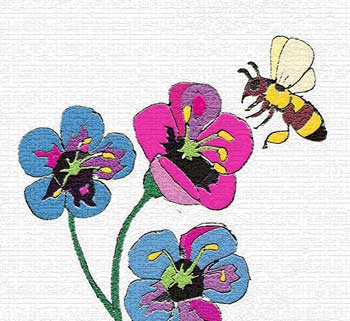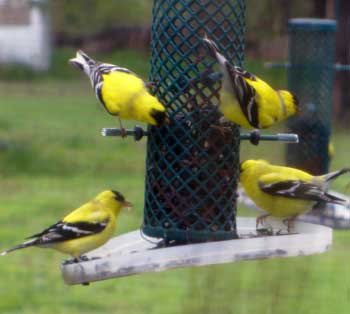What Can You Do to Help Honeybees and Bumblebees?
Seven Ways to Make Your Yard "Bee" Friendly:
- Avoid Pesticides: Stop using pesticides in your yards, gardens and farms, especially imidacloprid and other neonicotinoid pesticides. Support organic agriculture by growing and buying naturally produced food. Farmers check out this great Xerces pamphlet on Farming For Bees: Guidelines for Providing Native Bee Habitat on Farms.
- Provide Food: Many people are choosing to help bees by adding bee friendly plants to their yard. Planting nectar and pollinator plants provides habitat to help support honeybees and native pollinators.
 Provide Water: Bees need water to drink and to cool their nests. Water features also add something special to landscaping and attract other wildlife.
Provide Water: Bees need water to drink and to cool their nests. Water features also add something special to landscaping and attract other wildlife.- Add More Flowers: Give the bees even more food by populating your yard with blooming plants. Try to have something blooming all season. Planting blooming plants of all kinds helps pollinators and will get you more compliments on your yard as well!
- Provide Attractive Nests: check out the fun Xerces Society fact sheet on how to make nests for native wood nesting bees and how to help encourage native ground nesting bees.
- Be Careful of Nursery Plants: Watch out for garden center bedding or garden plants sprayed with bee killing insecticides. Sadly, some of these sprayed plants are even labeled bee friendly! A recent study coauthored by the Pesticide Research Institute, showed that 7 out of 13 samples of garden plants sold at nurseries contained neonicotinoid pesticides lethal to bees. For more on this topic see this report commissioned by Friends of the Earth: Gardeners Beware 2016: Bee-toxic Pesticides Found in "Bee-Friendly" Plants Sold at Garden Centers National Wide.
- Be more Tolerant: If you chose not to grow organically at least be tolerant; are the dandelions or aphids so bad that you need to nuke your entire yard with poisons? I know that some people don't like insects but try to move away from a scorched earth policy of pest control. No one wants to be the North Korea of bug control. Find and use chemicals that aren't toxic to pollinators such as honeybees. Read pesticide directions and try to target treatments towards the pest you want to control (see Xerces Society fact sheet on Organic-Approved Pesticides Minimizing Risks to Bees). More chemical runoff occurs from homes and yards than from agricultural land. That is because farmers are careful and have to follow application requirements when spraying chemicals. Homeowners tend to think that if a little is good the whole bottle is better. Remember, what kills bees is also bad for you, bad for birds, bad for your pets and bad for your kids.
Read and Think About the Bee Problem:
- See Who is Talking About Bees: Be suspicious of studies or PR statements originating from organizations that sell and develop pesticides and genetically engineered food. Many of these try to minimize the bee die off connection with pesticides. For an article about inadequate watchdogging by the EPA when it comes to big chemical companies see "Leaked document shows EPA allowed bee-toxic pesticide despite own scientists' red flags" by Tom Philpott. Look for independent studies by reliable researchers to get the most accurate picture of the problem.
- Check the Bee Facts: Make sure to check that scientific facts are presented along with statements. I try to give you the facts and links to the original research studies I discuss so that you can decide for yourself if something seems to be harmful to bee populations. For more information about CCD and the threat to our food supply see the great free PDF bee booklets below.
- Lobby to Protect Bees: Demand the restriction of pesticides that adversely affect bees and birds and threaten our food supply. Pesticides include insecticides, fungicides and herbicides. These chemicals are part of the problem and need to be used in a careful way in an integrated pest management system. Personally, I choose not to use chemical control in my garlic, garden or yard. Support measures that add green space to urban areas. For more ways to save the bees see take action to protect bees below.
Raise Bees Yourself:
- Put up a hive for mason bees or other native bees.
- Talk to a local beekeeper about their work. You may want to raise honeybees yourself! There is a large shortage of USA honey and many people desire all natural unfiltered honey.
- If you raise honeybees don’t feed them high fructose corn syrup! If you need to give bees a supplement, try to find a safe organic sugar source for them (or share the honey with them). Try to avoid exposing your bees to pesticides.
Take Action to Help Bees (and Birds)!
- Check out the Friends of the Earth Bee Action campaign which sent valentines to Home Depot and Lowes asking them to stop using bee-killing pesticides on their plants.
- Take the honeybee pledge at Honey Haven to protect our buzzy pollinators. Download a honeybee tool kit to learn how to enact change in your community by writing letters, leading discussions, hosting film screenings or organizing events. This PDF has very clear concise step by step instructions on effective ways to engage your community.
- The center for Food Safety and Beyond Pesticides started a BEE Protective Campaign.
- Get involved with the Xerces Society which advocates on behalf of the bees. The Xerces Society is concerned with conserving invertebrates of all types and stripes.
- Check out the Bumblebee Watch and record your bumblebee sightings!
Do you want to know more about the plight of the bees? Check out these great free resources:
Honey Bees and Pesticides: State of the Science. By Heather Pilatic, PHD. 2012. (22 page PDF report on the factors behind colony collapse disorder that you can read or download for free at PAN North America)
A Review of Research into the Effects of Neonicotinoid Insecticides on Bees, with Recommendations for Action By Jennifer Hopwood, Mace Vaughan, Matthew Shepherd, David Biddinger, Eric Mader, Scott Hoffman Black, and Celeste Mazzacano. 2012. (44 page PDF copy available or the 2 page
Bee Informed Partnership: website that looks at data from thousands of beekeepers.
 summary at the Xerces Society that you can download or read for free)
summary at the Xerces Society that you can download or read for free)
Picture: Yellow finches enjoy oil seed sunflower seeds.
What about the plight of the birds?
Neonicotinoid pesticides kill more than bees, they are also dangerous for songbirds and aquatic systems. A report commissioned by American Bird Conservancy (ABC) stated that one corn kernel or wheat seed treated with the neonicotinoid insecticide Imidacloprid can kill an average sized songbird. A tenth of that amount can affect a songbird's reproductive ability. For more information see ABC's report, "The Impact of the Nation's Most Widely Used Pesticide on Birds" American Bird Conservatory March 2013 by Dr. Pierre Mineau and Cynthia Palmer.
